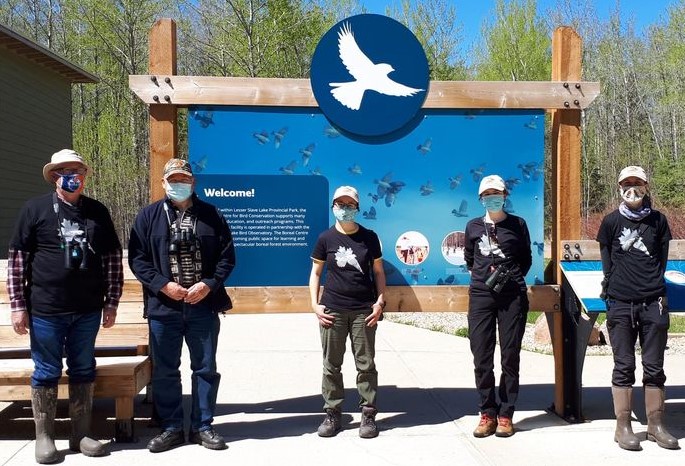As promised, results are in for the Lesser Slave Lake Bird Observatory’s annual fundraiser: the Great Canadian Birdathon. If you feel out of the loop, during the Birdathon teams across Canada do a marathon of birding, trying to find as many bird species as possible within 24 hours to collect donations for their favourite local bird conservation groups.

Above: Team Tanager scoping out the Boreal Centre for Bird Conservation. Left to right: Wayne Bowles, Al Hovan, Sachi Schott, Bronwyn Robinson, and Robyn Perkins.
This year the LSLBO had two teams competing with each other. “Team Tanager” is our field staff plus two long term supporters, Wayne Bowles and Al Hovan. They covered the area around Slave Lake on May 21 after spending the morning working at the monitoring station. Their competition was Nicole and Richard Krikun, who ‘retired’ from the LSLBO in 2018. They competed as “Birders in the Park” and scoured areas west of Edmonton on May 23.
Team Tanager did well for itself and found 100 species (Table 1), surpassing their 2020 species total of 92. They had two highlights. The first was a stunning male Oregon Junco. Like the locally common Slate-coloured Junco, Oregon Juncos are a subspecies of Dark-eyed Junco. However, they are more commonly found west of the Rockies making them a rare find. The second highlight was a pair of Cinnamon Teal – a small duck that breeds in the prairies of Alberta and rarely ventures this far north.

Above: This year’s winners Birders in the Park. Nicole Krikun (left) and Richard Krikun (right) had a great jaunt in the Fort Assiniboine Sandhills Wildland.

Above: This little fluffball of a Philadelphia Vireo was one of the four species of vireo found by Team Tanager during their Birdathon!
Nonetheless claiming the bragging rights was team Birders in the Park, who did even better with 106 species, although down from 136 in 2020. Highlights for them were plentiful and included Veery, Cape May Warbler, Western Grebe, Bay-breasted Warbler, Pectoral Sandpiper, and Bobolink!
As for what has been happening at the bird observatory over the past week, it has again been very slow and we have not seen much active migration. Canada Warblers and several other warbler species appear to be moving through the area in low numbers. Calmer and warmer weather has helped our capture rates by allowing us to have the nets open more frequently than the preceding week and 162 birds were banded. Some of which are beginning to show signs that eggs will soon be laid in nests hidden in every layer of the forest. So far this season, we have banded 418 birds from 40 species.
The LSLBO will continue to be closed to the public during the spring migration season, but you can keep up-to-date through both these articles and our Facebook page at “Lesser Slave Lake Bird Observatory”!
To congratulate Team Birders in the Park:
www.canadahelps.org/en/charities/bird-studies-canada/p2p/birdathon21/page/birders-in-the-park/
To offer condolences to Team Tanager:
www.canadahelps.org/en/charities/bird-studies-canada/p2p/birdathon21/team/tanager/
By Robyn Perkins, LSLBO Bander-in-Charge
Table 1: Species observed by Team Tanager around Slave Lake (taxonomic order):
| 1. Canada Goose
2. American Wigeon 3. Mallard 4. Blue-winged Teal 5. Northern Shoveler 6. Green-winged Teal 7. Cinnamon Teal 8. Canvasback 9. Ring-necked Duck 10. Greater Scaup 11. Lesser Scaup 12. Surf Scoter 13. White-winged Scoter 14. Long-tailed Duck 15. Bufflehead 16. Common Goldeneye 17. Common Merganser 18. Red-breasted Merganser 19. Ruffed Grouse 20. Common Loon 21. Pied-billed Grebe 22. Red-necked Grebe 23. Double-crested Cormorant 24. American White Pelican 25. Osprey 26. Bald Eagle 27. Sharp-shinned Hawk 28. Red-tailed Hawk 29. Sora 30. American Coot 31. Killdeer 32. Spotted Sandpiper 33. Solitary Sandpiper 34. Franklin’s Gull 35. Ring-billed Gull |
36. Common Tern
37. Forster’s Tern 38. Great Gray Owl 39. Belted Kingfisher 40. Yellow-bellied Sapsucker 41. Downy Woodpecker 42. Hairy Woodpecker 43. Merlin 44. Alder Flycatcher 45. Least Flycatcher 46. Eastern Phoebe 47. Blue-headed Vireo 48. Warbling Vireo 49. Philadelphia Vireo 50. Red-eyed Vireo 51. Gray Jay 52. Blue Jay 53. Black-billed Magpie 54. American Crow 55. Common Raven 56. Tree Swallow 57. Cliff Swallow 58. Barn Swallow 59. Black-capped Chickadee 60. Red-breasted Nuthatch 61. White-breasted Nuthatch 62. Brown Creeper 63. Ruby-crowned Kinglet 64. Winter Wren 65. Marsh Wren 66. Swainson’s Thrush 67. Hermit Thrush 68. American Robin 69. Ovenbird 70. Northern Waterthrush |
71. Black-and-white Warbler
72. Tennessee Warbler 73. Common Yellowthroat 74. American Redstart 75. Magnolia Warbler 76. Yellow Warbler 77. Myrtle Warbler 78. Black-throated Green Warbler 79. Canada Warbler 80. Chipping Sparrow 81. Clay-colored Sparrow 82. Savannah Sparrow 83. Le Conte’s Sparrow 84. Song Sparrow 85. Lincoln’s Sparrow 86. Swamp Sparrow 87. White-throated Sparrow 88. White-crowned Sparrow 89. Oregon Junco 90. Western Tanager 91. Rose-breasted Grosbeak 92. Red-winged Blackbird 93. Brewer’s Blackbird 94. Common Grackle 95. Brown-headed Cowbird 96. Baltimore Oriole 97. Purple Finch 98. Pine Siskin 99. Evening Grosbeak 100. House Sparrow
|
